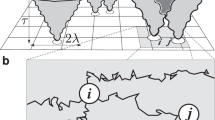Abstract
This paper discusses a study on the mechanism of self-organization. A global order is organized by the simple and locally coordinated actions of autonomous agents using only local information, so complex or globally coordinated actions which use global communication and high-level strategies are not necessary. The fundamental factors for establishing a global order using self-organization are a “dissipative structure,” an “autocatalysis mechanism,” and “intentional fluctuations.” If an environment where there are agents has a dissipative structure and those agents have some sort of autocatalysis and intentional fluctuation mechanisms within themselves, it is possible to form a global order for them using only their simple and locally coordinated actions. “The blind-hunger dilemma” is used as an example to simulate the self-organization and coordinated actions of agents. In this simulation environment, there are many ant-like agents which must get energy. However, there is only one small energy supply base, so either an efficient method or the coordinated actions of agents is needed. As a result, the agents using our approach could move and get energy more efficiently than agents using conventional coordination mechanisms involving global communication and high-level strategies.
Similar content being viewed by others
Explore related subjects
Discover the latest articles, news and stories from top researchers in related subjects.References
Numaoka C (1995) Introducing the blind hunger dilemma: agent properties and performance. Proceedings of ICMAS'95, pp. 290–296
O'Hare GMP, Jennings NR (1996) Foundations of distributed artificial intelligence. Wiley, New York
Ekenberg L (1996) Modelling Decentralised Decision Making. Proceedings of ICMAS'96, pp. 64–71
Balch T, Arkin RC (1995) Motor Schema-Based Formation Control for Multiagent Robot Teams. Proceedings of ICMAS'95, pp. 10–16
Nicolis G, Prigogine I (1977) Self-organization in nonequilibrium systems. Wiley, New York
Haken H (1983) Instability of self-organizing system and devices. Springer, Berlin
Deneubourg JL (1991) The dynamics of collective sorting robot-like ants and ant-like robots. Proceedings of the First International Conference on Simulation of Adaptive Behavior: From Animals to Animals, pp. 356–363
Goss S, Deneubourg JL (1992) Harvesting by a group of robots. Proceedings of the First European Conference on Artificial Life: Toward a Practice of Autonomous Systems, pp. 71–80
Kubo M, Kakazu Y (1994) Evaluation of coordinated motions of multi-agent systems on competition for food between ant colonies (in Japanese). J Inf Proc Soc J 35:1555–1566
Yamada S (1996) Controlling deliberation with success probability in a dynamic environment. Proceedings of AIPS'96, pp. 251–258
Georgeff MP, Lansky AL (1987) Reactive reasoning and planning. Proceedings of AAAI, pp. 677–682
Kurihara S, Okada M, Nakatsu R (1995) A coordinative structure in man-machine interactions. Proceedings of HCI'95, pp. 123
Author information
Authors and Affiliations
Corresponding author
About this article
Cite this article
Kurihara, S., Sugawara, T. & Onai, R. Self-organization based on nonlinear nonequilibrium. Dynamics of autonomous agents. Artificial Life and Robotics 2, 102–107 (1998). https://doi.org/10.1007/BF02471164
Received:
Accepted:
Issue Date:
DOI: https://doi.org/10.1007/BF02471164




